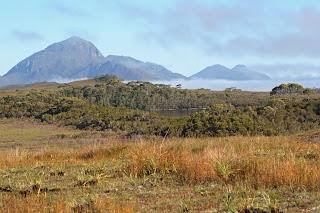Come Fly With Me
The Orange-bellied Parrot only makes headlines for two ominous reasons: either the species is blamed for threatening coastal developments (most recently a marina in Western Port Bay , south of Melbourne Tasmania
The plants are low and shrubby on the buttongrass moorlands of Melaleuca, in southwest Tasmania
But these pretty plants are of scant interest to my fellow birdwatchers and me. Late last year, we visited Melaleuca, in Tasmania
This summer was decisive for the critically endangered bird, which is only found in southern Australia Victoria , Tasmania , South Australia
Does anyone catch a whiff of the Tasmanian Tiger story in this? In 1936, the last thylacine perished in captivity: a wild animal, caught, alone and caged in the Hobart Zoo. Orange-bellied parrots could end up as museum pieces, too.
The birds at Melaleuca now number a scant 34 and the wild total is almost certainly no more than 50. With only eight females presently nesting at Melaleuca, it remains to be seen whether successful breeding has taken place.
By February last year, 27 chicks had fledged, which was judged a breeding success. It was certainly more than double the output from the previous two years, when it’s believed not enough females attempted to breed.
It’s not clear why this occurs. Scientists refer to possible ‘inbreeding depression’, a condition in which the ability to survive and reproduce is reduced by the mating of closely related individuals. Or is it something to do with degraded mainland habitats, where they migrate for the winter? Or perhaps the recent years of severe drought?
Last winter, several parrots were seen 26 times on the mainland in Victoria Bass Strait in good enough condition to breed once they reached Melaleuca. But even in favourable conditions, a 45g bird flying across Bass Strait twice a year is the equivalent of an ultra-marathon. Compounding the population’s steep decline was last year’s decision to remove 21 juveniles hatched in the wild. These were sentto breeding facilities in order to bolster the captive flock’s gene pool.
Scientists aim to increase this captive flock as quickly as possible. When it reaches 400, large numbers will be released at Melaleuca. Will this succeed? Will there be enough genetic variation to sustain the parrots? Will there even be any wild birds left? Much is at stake for the bird the former Victorian premier, Jeff Kennett, once dubbed a ‘trumped-up corella’.
***
For two weeks, I volunteered at Melaleuca. Twice daily, my colleagues and I sprinkled sprouted canary seed on a stainless steel table laid with rubber mats (which stopped seed blowing away and gave the birds a foothold). Reading their leg bands, we noted each arrival. Danger was all around for the sociable, buzzy creatures, with swooping raptors and currawongs in the sky, and tiger snakes on the ground. The table’s legs were smeared with grease to repel the latter, while the observation point itself had been moved, partly to avoid proximity to chick-eating currawongs.
We sat for two hours, morning and evening, in a flimsy tent in the middle of the windswept plain, peering through a telescope. South was the quartzite-studded hulk of the New Harbour Range ; to the north, Mount Rugby ’s jagged outline. And before us, up to eight at a time, the bright green, blue, orange, yellow, aqua and orange-bellied parrots shoved their beaks into piles of small yellow seed.
Most birds sported the coloured and lettered leg bands, which help trace their breeding and migration. (Six were unbanded – which raises the question of where they came from.) We got to know them individually, like pets: Yellow Blue D’s sapphire forehead was patchy on one side; Silver Red M turned up with a female and, unforgettably, fed her, regurgitating his own meal into her upturned beak. Another unbanded female looked tufty and bedraggled, beginning to moult after two months in her nest.
We listened intently. Long before they flew in, they called their distinctive, metallic ziiitttt! then perched near the table before alighting, momentarily confident of their safety. Every day, their arrow-shaped silhouettes zapped clear across the plain.
The weather in southwest Tasmania
The answer lies in the vegetation. Plants like paper daisy and dozens of grasses and sedges provide a reliable summer diet. The birds feed near the ground and nest in the hollows of peppermint gums on the edge of the plains and in valleys surrounding Melaleuca. Also, since the 1980s, in wooden nestboxes. When hungry, a free feed awaits at the feeding table – maintained by anxious, hopeful volunteers like me – throughout the summer.
The Commonwealth, Victorian, South Australian and Tasmanian governments provide funding for orange-bellied parrot work. This year will see the release of a new five-year plan, in which scientists cost the work that’s needed. But since the first plan was produced in 1984, a proposed action-plan has never been fully funded. Without adequate funding, the team responsible for saving the orange-bellied parrot is unable to do its work properly. Moreover, the team’s members have other responsibilities; nobody works full-time on orange-bellied parrot conservation.
This bird doesn’t deserve to be blamed for being helped to stay alive, even if doing so means some developments are occasionally stalled. If the orange-bellied parrot disappears, another facet of what makes Australia
Debbie Lustig administers ‘Save the Orange-bellied Parrot’ on Facebook: https://www.facebook.com/savetheobp. The Wildcare ‘Save the Orange-bellied Parrot Fund’ will aid research and conservation: http://www.wildcaretas.org.au/programs?corporate_type_ID=9
Photograph of Melaleuca by Chris Tzaros; Orange-bellied Parrot photo by Debbie Lustig. This article first appeared in The Big Issue No 402 13-26 March 2012.

